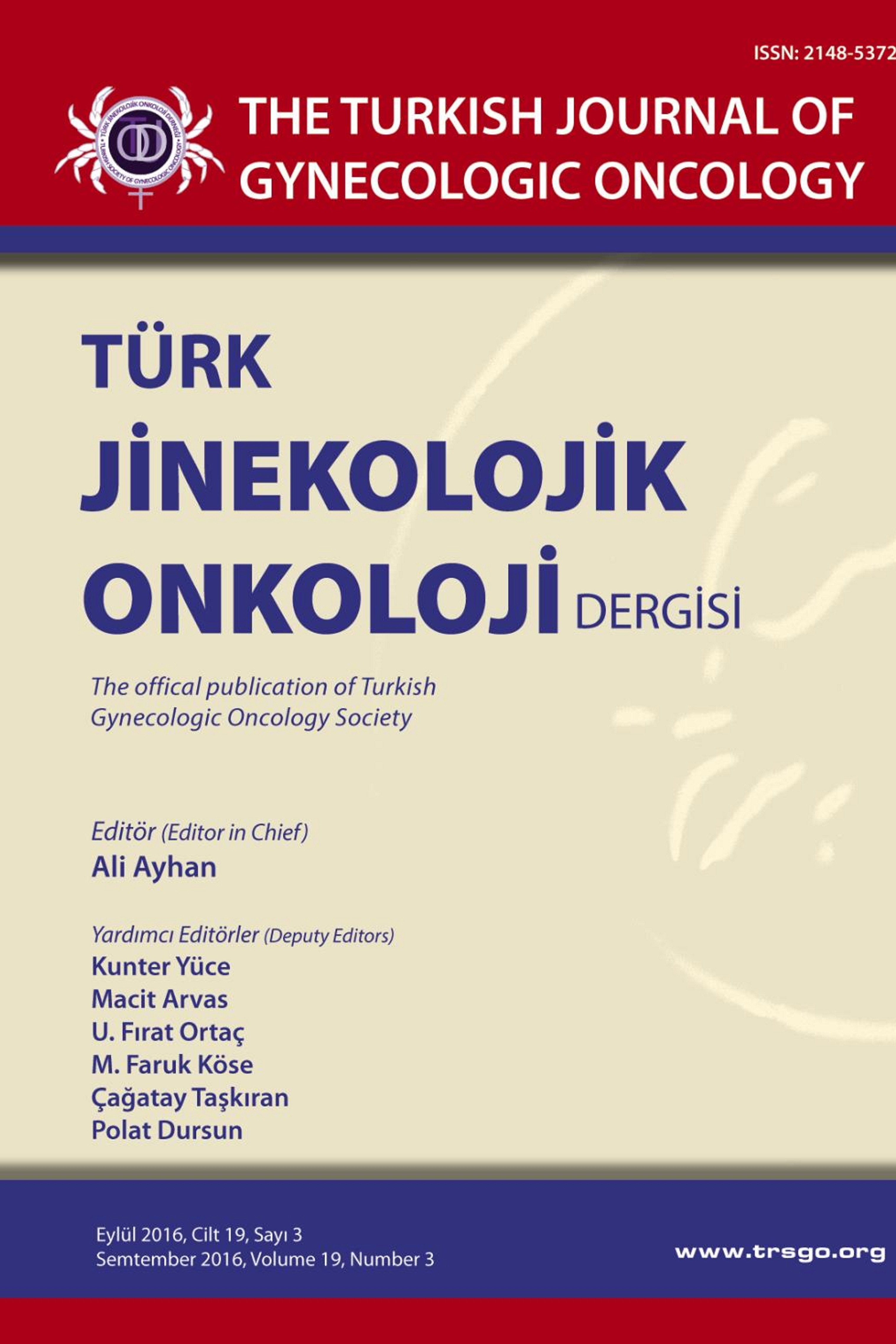DİSFONKSİYONEL UTERİN KANAMA TEDAVİSİNDE LEVONORGESTREL SALINIMLI İNTRAUTERİN SİSTEMİN ROLÜ
Levonorgestrel Salınımlı İntrauterin Sistem, Disfonksiyonel Uterin Kanama, Menoraji.
Levonorgestrel-releasing Intrauterine System, Dysfunctional Uterine Bleeding, Menorrhagia,
___
- 1. Stewart A, Cummins C, Gold L, Jordan R, Phillips W. The effectiveness of the levonorgestrel-releasing intrauterine system in menorrhagia: a systematic review. BJOG. 2001;108(1):74-86.
- 2. Monteiro I, Bahamondes L, Diaz J, Perrotti M, Petta C. Therapeutic use of levonorgestrel-releasing intrauterine system in women with menorrhagia: a pilot study. Contraception. 2002;65(5):325-8.
- 3. Kriplani A, Singh BM, Lal S, Agarwal N. Efficacy, acceptability and side effects of the levonorgestrel intrauterine system for menorrhagia. Int J Gynaecol Obstet. 2007;97(3):190-4.
- 4. Hurskainen R, Teperi J, Rissanen P, Aalto AM, Grenman S, Kivelä A, Kujansuu E, Vuorma S, Yliskoski M, Paavonen J. Quality of life and cost-effectiveness of levonorgestrel-releasing intrauterine system versus hysterectomy for treatment of menorrhagia: a randomised trial. Lancet. 2001;357(9252):273-7.
- 5. Sculpher MJ, Dwyer N, Byford S, Stirrat GM. Randomised trial comparing hysterectomy and transcervical endometrial resection: effect on health related quality of life and costs two years after surgery. Br J Obstet Gynaecol. 1996;103(2):142-9.
- 6. Concin H, Bösch H, Hintermüller P, Hohlweg T, Mursch-Edlmayr G, Pinnisch B, Schmidl-Amann S, Schulz-Greinwald G, Unterlerchner D, Wagner T, Mattle V, Wildt L, Fiala C. Use of the levonorgestrel-releasing intrauterine system: an Austrian perspective. Curr Opin Obstet Gynecol. 2009;21 Suppl 1:S1-9.
- 7. Vercellini P, Viganò P, Somigliana E. The role of the levonorgestrel-releasing intrauterine device in the management of symptomatic endometriosis. Curr Opin Obstet Gynecol. 2005;17(4):359-65.
- 8. Bragheto AM, Caserta N, Bahamondes L, Petta CA. Effectiveness of the levonorgestrel-releasing intrauterine system in the treatment of adenomyosis diagnosed and monitored by magnetic resonance imaging. Contraception. 2007;76(3):195-9.
- 9. Jones RL, Critchley HO. Morphological and functional changes in human endometrium following intrauterine levonorgestrel delivery. Hum Reprod. 2000;15 Suppl 3:162-72.
- 10. Nilsson CG, Haukkamaa M, Vierola H, Luukkainen T. Tissue concentrations of levonorgestrel in women using a levonorgestrel-releasing IUD. Clin Endocrinol (Oxf). 1982;17(6):529-36.
- 11. Hurskainen R, Salmi A, Paavonen J, Teperi J, Rutanen E. Expression of sex steroid receptors and Ki-67 in the endometria of menorrhagic women: effects of intrauterine levonorgestrel. Mol Hum Reprod. 2000;6(11):1013- 8.
- 12. Rutanen E, Hurskainen R, Finne P, Nokelainen K. Induction of endometrial plasminogen activator-inhibitor 1: a possible mechanism contributing to the effect of intrauterine levonorgestrel in the treatment of menorrhagia. Fertil Steril. 2000;73(5):1020-4.
- 13. Pakarinen P, Luukkainen T, Laine H, Lähteenmäki P. The effect of local intrauterine levonorgestrel administration on endometrial thickness and uterine blood circulation. Hum Reprod. 1995;10(9):2390-4.
- 14. Orbo A, Arnes M, Pettersen I, Larsen K, Hanssen K, Moe B. Down-regulated progesterone receptor A and B coinciding with successful treatment of endometrial hyperplasia by the levonorgestrel impregnated intrauterine system. Acta Obstet Gynecol Scand. 2010;89(11):1438-46.
- 15. Lee SY, Kim MK, Park H, Yoon BS, Seong SJ, Kang JH, Jun HS, Park CT. The effectiveness of levonorgestrel releasing intrauterine system in the treatment of endometrial hyperplasia in Korean women. J Gynecol Oncol. 2010;21(2):102-5.
- ISSN: 2148-5372
- Başlangıç: 2014
- Yayıncı: Türk Jinekolojik Onkoloji Derneği
JİNEKOLOJİK KANSER TANISI ALMANIN PSİKOSOSYAL BOYUTU VE HEMŞİRELİK YAKLAŞIMLARI
Müjdegül ZAYIFOĞLU KARACA, Oğuz Devrim YARDIMCI, Eralp BAŞER, Serap AKBAY, Gülnur GÜREL, Tayfun GÜNGÖR
KONİZASYON SONRASI OLUŞAN SERVİKAL STENOZUN FOLEY SONDA İLE TEDAVİSİ
Simender MESCİ HAFTACI, M. Faruk KÖSE
MATÜR KİSTİK TERATOMLARDA TÜMÖR MARKERLERİ
Salih Burçin KAVAK, Ebru ÇELİK, Bilgin GÜRATEŞ, Yakup BAYKUŞ, Hüsnü ÇELİK
DİSFONKSİYONEL UTERİN KANAMA TEDAVİSİNDE LEVONORGESTREL SALINIMLI İNTRAUTERİN SİSTEMİN ROLÜ
